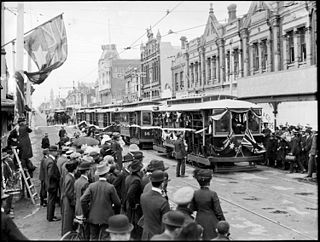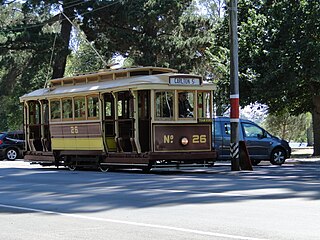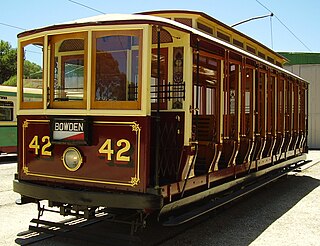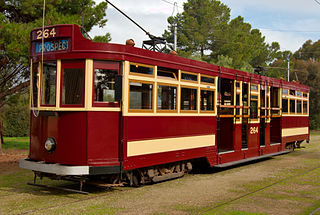
A Birney or Birney Safety Car is a type of streetcar that was manufactured in the United States in the 1910s and 1920s. The design was small and light and was intended to be an economical means of providing frequent service at a lower infrastructure and labor cost than conventional streetcars. Production of Birney cars lasted from 1915 until 1930, and more than 6,000 of the original, single-truck version were built. Several different manufacturers built Birney cars. The design was "the first mass-produced standard streetcar " in North America.

The Adelaide tramway network served much of the inner suburbs and a few outer suburbs of Adelaide, Australia, from 1878 up until the 1950s when the network started to decline. The sole Glenelg light rail line was the only route to survive the closures and has remained in operation ever since. After falling into a state of disrepair and neglect, it underwent major upgrades and extensions in the 2000s with a new tram fleet and major extensions.

The Prahran and Malvern Tramways Trust (PMTT) was a former tram operator in Melbourne, Australia. The trust was formed in 1907, with its first line operating in 1910. Its functions were taken over by the Melbourne & Metropolitan Tramways Board in 1920.

The earliest trams in Australia operated in the latter decades of the 19th century, hauled by horses or "steam tram motors". At the turn of the 20th century, propulsion almost universally turned to electrification, although cable trams lingered in Melbourne. In cities and towns that had trams, they were a major part of public transport assets.

The H type Adelaide tram was a class of 30 trams built by A Pengelly & Co, Adelaide in 1929 for use on the newly constructed Glenelg tram line. They remained in regular revenue service until replaced by Bombardier Flexity Classic trams in 2006.

The Adelaide trolleybus system formed part of the public transport network in Adelaide, South Australia from 1932 until 1963.

The city of Geelong in Victoria, Australia, operated an extensive tramway system from 1912 until 1956, when the service was replaced by buses. Unlike Victoria's other major regional cities, Ballarat and Bendigo, which have kept some track and trams as tourist attractions, no trams or tracks remain in Geelong.

The C-class was a group of 11 trams built by Duncan & Fraser, Adelaide for the Prahran & Malvern Tramways Trust (P&MTT) in 1913, numbered 25 to 35. All retained their fleet numbers when passed to the Melbourne & Metropolitan Tramways Board (M&MTB) on 2 February 1920, after it took over the P&MTT. They were designated C-class sometime after October 1921, and by late 1923, all M&MTB drop-end-and-centre Maximum Traction trams were grouped together as C-class trams. The 22E Maximum Traction trucks were of JG Brill design, although manufactured by Brush in England.

The M-class was a class of 17 trams built by Duncan & Fraser, Adelaide for the Hawthorn Tramways Trust (HTT) as numbers 1 to 10, and 33 to 39. All passed to the Melbourne & Metropolitan Tramways Board on 2 February 1920 when it took over the Municipal Tramway Trusts, becoming the M-class and being renumbered 107 to 116, and 183 to 189.
The O-class Melbourne tram were a group of four trams built in 1912 by Duncan & Fraser (Adelaide) for the Prahran & Malvern Tramways Trust (P&MTT) upon the recommendation of W. G. T. Goodman, Chief Engineer and General manager of the Adelaide tramways. They were allocated P&MTT fleet numbers 21 to 24. At the time of their introduction, they were by far the largest street-vehicles in Melbourne, and earned the nicknames Zeppelins and Dreadnoughts. Proving to be less than satisfactory in service, they were later sold to the Hawthorn Tramways Trust (HTT) in August 1916 as "surplus to requirements", however P&MTT soon ordered replacement tramcars. Coincidentally they retained their fleet numbers whilst at Hawthorn.

The P-class was a class of eight trams built by Duncan & Fraser, Adelaide for the Hawthorn Tramway Trust (HTT) as numbers 25 to 32. All passed to the Melbourne & Metropolitan Tramways Board on 2 February 1920 when it took over the HTT becoming the P-class and being renumbered 131 to 138.

The Tramway Museum, St Kilda is Australia's principal museum of the 19th and 20th century trams of Adelaide, South Australia. It is situated at St Kilda, 24 kilometres north of the centre of Adelaide. It is operated by the Australian Electric Transport Museum (SA) Inc., a not-for-profit volunteer organisation affiliated with the Council of Tramway Museums of Australasia. It is dedicated to the study, conservation and restoration of trams that were used in Adelaide or built there, and likewise with a small bus and trolleybus collection.Trams provide unlimited free rides for visitors on payment of the entrance fee. They operate along a 1.6 kilometres purpose-built track between the museum and a large adventure playground.
This article describes the tram types in Adelaide that have operated for the past 146 years: from early days when they undertook a major share of the public transport task before car ownership was well established; through the 49-year period when only one tram line operated; to the city's 21st-century tramways revival.

The A type Adelaide tram was a class of 70 drop-end, Californian combination trams built by Duncan & Fraser, Adelaide in 1908/09 for the Municipal Tramways Trust (MTT). They were used on tram lines to Kensington, Marryatville, Maylands, Payneham, Wakerville, North Adelaide, Parkside, Unley and Hyde Park. In later years they were cascaded to quieter services to Croydon and the isolated Port Adelaide network.

The B type Adelaide tram was a class of 30 straight sill, open cross-bench trams built by Duncan & Fraser, Adelaide in 1909 for the Municipal Tramways Trust (MTT). Although popular in summer, they were less so in winter when exposed to inclement weather. Thus in 1917 with the MTT requiring more trams, 41-60 were converted to Californian combination trams, closely resembling the A type trams. When the MTT introduced an alpha classification system in 1923, they were designated the B type. Numbers 41-43 became the A2 type and 44-60 the A1 type. The A2s were used exclusively on the isolated Port Adelaide network.

The C type Adelaide tram was a class of 20 drop end, California combination trams built by Duncan & Fraser, Adelaide in 1918 for the Municipal Tramways Trust (MTT). All were delivered in 1918, but as they were receiving second-hand motors from the E type trams, the last did not enter service until September 1919. When the MTT introduced an alpha classification system in 1923, they were designated the C type.
The Adelaide D type tram was a class of trams operated by the Municipal Tramways Trust on the Adelaide tram network from 1910 until 1958.

The E type Adelaide tram was a class of 20 bogie, half open, half closed combination trams with one drop and one straight sill end built by A Pengelly & Co, Adelaide in 1910 for the Municipal Tramways Trust (MTT). In 1918/19, all were remotored with 65 hp General Electric 201s with the original 50 hp General Electric 202s reused in the C type trams. When the MTT introduced an alpha classification system in 1923, they were designated the E type. In 1936, all were converted to E1s with crossbenches removed and the saloon extended along the full length.

The F type Adelaide tram was a class of 84 bogie, drop centre, combination trams built between 1921 and 1929 for the Municipal Tramways Trust (MTT). All bar three were built by A Pengelly & Co, Adelaide with 262, 283 and 284 being built by the MTT's Hackney workshops. The first 50 were built as the F type, while the last 34 were classified as the F1 type, the latter having an all steel as opposed to partly wooden underframe. Some remained in service until the network closed in November 1958.
The Melbourne tram network began in 1884 with the construction of the Fairfield Horse Tramway. However, the purpose of the line was to increase land prices in the area, and it soon closed during the depression in 1890. The first genuine attempt to construct a tramway network was the construction of the Richmond cable tram line by the Melbourne Tramway & Omnibus Company in 1885. Over the next few years, 16 more cable tram lines were constructed, as well as numerous other horse tramways. The depression of the early 1890s slowed further expansion of the cable network. The first electric tram line was the Box Hill and Doncaster tramway which opened in 1889. This was a pioneering line in what was then the countryside and thus didn't receive much patronage. It closed in 1896. The next attempt at an electric tramway was Victorian Railways' St Kilda to Brighton line, which opened in 1906. Later that year, the North Melbourne Electric Tramway & Lighting Company opened lines to Essendon and Maribyrnong. Many local councils formed their own tramway trusts and built tramways within their own constituency. The most successful of these was the Prahran & Malvern Tramways Trust.
















